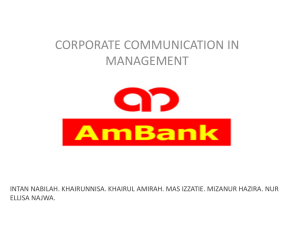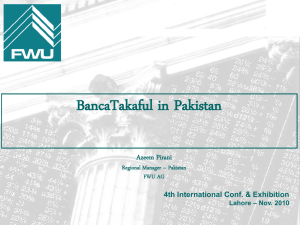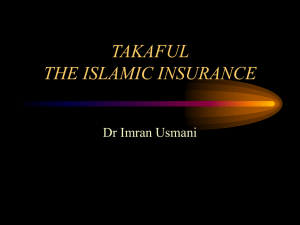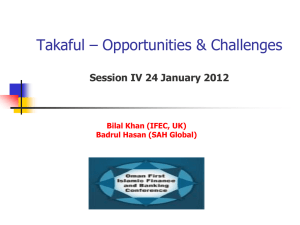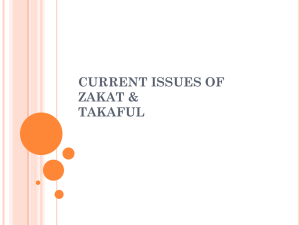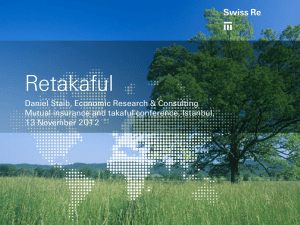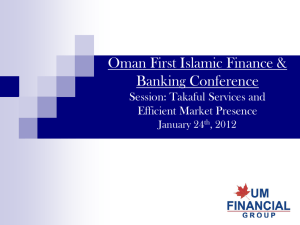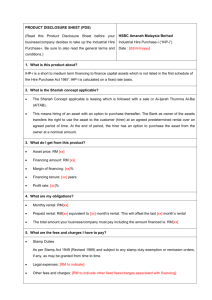Document 10465336
advertisement
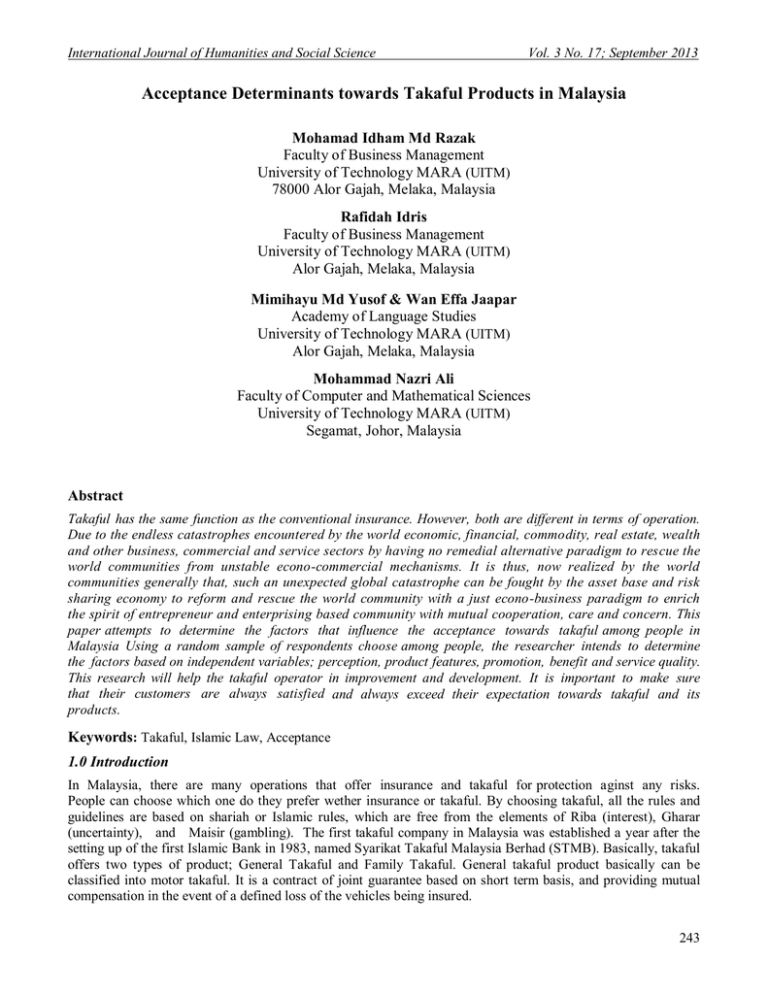
International Journal of Humanities and Social Science Vol. 3 No. 17; September 2013 Acceptance Determinants towards Takaful Products in Malaysia Mohamad Idham Md Razak Faculty of Business Management University of Technology MARA (UITM) 78000 Alor Gajah, Melaka, Malaysia Rafidah Idris Faculty of Business Management University of Technology MARA (UITM) Alor Gajah, Melaka, Malaysia Mimihayu Md Yusof & Wan Effa Jaapar Academy of Language Studies University of Technology MARA (UITM) Alor Gajah, Melaka, Malaysia Mohammad Nazri Ali Faculty of Computer and Mathematical Sciences University of Technology MARA (UITM) Segamat, Johor, Malaysia Abstract Takaful has the same function as the conventional insurance. However, both are different in terms of operation. Due to the endless catastrophes encountered by the world economic, financial, commodity, real estate, wealth and other business, commercial and service sectors by having no remedial alternative paradigm to rescue the world communities from unstable econo-commercial mechanisms. It is thus, now realized by the world communities generally that, such an unexpected global catastrophe can be fought by the asset base and risk sharing economy to reform and rescue the world community with a just econo-business paradigm to enrich the spirit of entrepreneur and enterprising based community with mutual cooperation, care and concern. This paper attempts to determine the factors that influence the acceptance towards takaful among people in Malaysia Using a random sample of respondents choose among people, the researcher intends to determine the factors based on independent variables; perception, product features, promotion, benefit and service quality. This research will help the takaful operator in improvement and development. It is important to make sure that their customers are always satisfied and always exceed their expectation towards takaful and its products. Keywords: Takaful, Islamic Law, Acceptance 1.0 Introduction In Malaysia, there are many operations that offer insurance and takaful for protection aginst any risks. People can choose which one do they prefer wether insurance or takaful. By choosing takaful, all the rules and guidelines are based on shariah or Islamic rules, which are free from the elements of Riba (interest), Gharar (uncertainty), and Maisir (gambling). The first takaful company in Malaysia was established a year after the setting up of the first Islamic Bank in 1983, named Syarikat Takaful Malaysia Berhad (STMB). Basically, takaful offers two types of product; General Takaful and Family Takaful. General takaful product basically can be classified into motor takaful. It is a contract of joint guarantee based on short term basis, and providing mutual compensation in the event of a defined loss of the vehicles being insured. 243 © Center for Promoting Ideas, USA www.ijhssnet.com In the case of Malaysia, the government’s aspiration toward Takaful industry is to create an efficient, progressive and comprehensive Islamic financial system that contributes significantly to the effectiveness and efficiency of the Malaysian financial sector while meeting the economic needs of the nation. In line with this, Bank Negara Malaysia deputy director Azleena Idris (2011) stated that the success of the industry lies in its ability to collectively position itself strategically to meet the needs of the economy and the ability to be competitive and innovative. The Takaful industry is viewed as an attractive business in Malaysia and there are tremendous growth opportunities for the insurance and Takaful industries in supporting the requirements of the economy. According to the Insurance Services Malaysia Berhad (ISM), as cited in Etiqa Takaful Berhad (2011) the Takaful industry in Malaysia has been experiencing steady growth and rapid changes over the last 5 years. This can be seen through its business performance from 2005 to 2009 whereby the total Takaful industry grew by 32% in 2008 and 14% in 2009. It is reported that family Takaful new business grew by 36% in 2008, but posted a slower growth of 10% in 2009. At the same time general Takaful grew by 24% in 2008 and 2009. The Takaful industry has been blessed with tremendous growth and strong performance. According to EtiqaTakaful Bhd’s Chief Executive Officer, Shahril Azuar Jimin in the Evaluation of the Malaysian Takaful Industry (2011), the Takaful market has become more diverse internationally and locally as there has been a tremendous increase in the number of Takaful operators operating worldwide as well as in Malaysia. It showed that there were 181 Takaful operators in business worldwide in 2010. Meanwhile, in Malaysia, from just a single Takaful operator in 1984, it had 12 Takaful operators as at 2010. This tremendous increase of Takaful operators in Malaysia provides the opportunities that would lead to expansion of the Takaful market share and increased penetration. Although Malaysia’s Takaful industry has seen tremendous growth from year to year, it still lags behind its conventional peers in terms of total insurance market penetration and share. According to Takaful Ikhlas Sdn Bhd president and Chief Executive Officer Datuk Syed Moheeb Syed Kamarulzaman (2010), the penetration rate for Takaful in Malaysia was around 10%, compared with conventional insurance at 40%.In line with this, Syed Moheeb also highlighted that the primary Takaful market was the Muslim segment and the penetration was low due to affordability, lack of appreciation for wealth planning, lack of sharia (Islamic Law) compliant insurance products and awareness of such products. By referring to the total assets of Malaysian insurance and Takaful industry, it showed that the total fund assets for the Takaful industry was only RM6.89 billion in 2006 compared to conventional insurance, RM108.5 billion for the same period. By 2009 the total assets for the Takaful industry had increased by only RM12.4 billion compared to RM148.6 billion for conventional insurance. In terms of the total assets of the insurance and Takaful industry, the percentage for Takaful fund was far behind the conventional insurance. Table 1.1: Takaful and Conventional Insurance Fund Assets Takaful Fund Assets 2006 2007 Total (RMb) 6.89 8.81 Family 5.8 7.4 General 1.1 1.4 % of Gross Nasional Income 1.2 1.6 % of total asssets of the insurance and 5.9 6.7 Takaful industry 2008 10.5 8.9 1.7 1.5 7.5 2009 12.4 10.5 1.9 1.0 8.0 Source: Bank Negara Malaysia (2010) Despite many incentives provided by the Malaysian government as a way to encourage more Malaysians to purchase Takaful products as well as to support the development of this industry in Malaysia, it is worthwhile to highlight that the majority of the population is still underinsured. Therefore this particular study would provide new insight into the factors that influence people to buy Takaful products and the level of acceptance towards takaful products. 2.0 Literature Review Customer According to Bank Negara, takaful is an insurance concept in shariah whereby a group of participants mutually agree among themselves to guarantee each other against defined loss or damage that may inflict upon any of them by contributing as tabarru' or donation in the takaful funds. 244 International Journal of Humanities and Social Science Vol. 3 No. 17; September 2013 While according to Muhammad Muslehuddin (1982) insurance is a provision made by a group of persons, each singly in danger of some loss, the incidence of which cannot be foreseen, that when such loss shall occur to any of them it shall be distributed over the whole group. Takaful in general is a system of Islamic insurance based on the principle of mutual cooperation (ta’awun) and donation (tabarru’), where the risk is shared collectively and voluntarily by the group of participants. It is derived from an Arabic word meaning ‘joint guarantee’ or ‘guaranteeing each other’ (Mahmood, 2008). It is an arrangement by a group of people with common interests to guarantee or protect each other from certain defined misfortunes such as premature death, disability and property damages (Obaidulllah, 2005). Under takaful schemes, participants mutually agree to guarantee and to protect each other against a defined loss or damage, by jointly providing financial assistance to any members suffering from a loss. Takaful literally means shared responsibility, shared guarantee, collective assurance and mutual undertakings. Thus Shariah compliant insurance is based on shared responsibility, mutual co-operation and solidarity and is designed to protect the participant against a defined risk. Takaful schemes are free from elements of gharar (uncertainty) in respect of premium and coverage, maisir (gambling) and riba (interest) (Dr. Mohd. Ma'sum Billah, 2004). Consumer acceptance is a complicated process involving societal attitudes. Based on Silberer and Wolfahrt (2001), acceptance research has provided important insights in explaining the success or failure of new product or services. Various product-specific drivers have been proposed, mostly in connection with marketing mix variables and product characteristics (Helsen and Schimittlein,1994). In addition, consumer acceptance reflects of their experience using a product. Then the company can show a positive or good image to their consumers with produce a good product that will give a good experience to them supported by (Soderlund, 1998) In addition, according to Mohd Ma'sum Billah (2004) in a following comparison between Islamic and conventional insurance contracts, the study continues by a survey of Takaful activities in various Asian countries, including Malaysia, Singapore, Indonesia, Saudi Arabia and Kuwait. The study concludes with reporting the future prospects of Takaful. It is our belief that understanding the nature of Takaful as well as comprehension of the arguments advocating it are necessary if this useful service is to gain wider acceptance. Zainal Abidin (2005) said that although its acceptance in the Muslim world was slow at first, the new millennium has seen a quickening in the pace. This has a lot to do with the emergence of a young generation of educated and affluent Muslims seeking a substitute for an important part of commerce and personal finance. For Muslims, Islam is not merely about how to go about worshipping God; it is also a way of living life. Moreover, according to Kotler and Amstrong (2004), perception can defined the process by which people selected, organize, and interpret information to form a meaningful picture of the world. A motivated person is ready to act. Furthermore, it’s influenced how the person acts by his or her own perception of the situation. All of us learn by the flow of information through our five senses: sight, hearing, smell, touch, and taste. However, each of us receive, organizes, and interprets this sensory information in an individual way. Quality has also been defined by the attributes of a product; for example, the unpriced attributes contained in the priced attributes (Lancaster, 1966), the amount of the secondly important attributes of a product per unit of the most important attribute (White, 1972), or the unmeasured attributes per unit of measured attributes (Leffler,1982). These measurement-oriented views assume that the manufacturer-designed attributes of a product are not fully transformed into a customer-perceived quality (Garvin, 1987; Reddy and Berger, 1983). Product quality from the consumer’s perspective is associated with the capacity of a product to satisfy consumer needs (Archibald et al., 1983; Gilmore, 1974; Groocock, 1986). The majority of marketing studies (Raimondo, 2000), trust can be as part of ‘brand credibility’, in product acceptance (Keller and Aaker, 1992), fundamental to develop of loyalty (Reicheld and Schefter, 2000) and as critical in maintaining successful agency-client relationship (Labahn and Kohli, 1997). There is, generally a paucity of trust related research in the consumer domain, although several recent publications focus on the consumer relationship with brand (Aaker 1997; Fournier, 998). Thus, since consumers have trusted any brand or products, it shows that their acceptance towards a product. Service quality is one of the most researched topics in the service marketing cluster. Service quality is being consider as a company’s competitive advantage and a route to corporate profitability (Newman, 2001), and according to Headley and Miller, (1993) service quality has now become a critical competitive consideration. Service quality is about meeting customer’s needs and requirements and how well the service being delivered matches the customer’s expectation (Al-Tamimi and Al- Amiri, 2003). 245 © Center for Promoting Ideas, USA www.ijhssnet.com For the case of the Islamic insurance industry, it is generally agreed that service quality plays an important role in sustaining the operator’s position in the highly competitive industry. 3.0 Methodology The nature and the purpose of this study is Hypothesis Testing. This study used cross sectional research design which is a study based on accumulated data analysis that provide insights to answering the research questions. Relevant literature, a pilot study and the actual design of research are the main procedure to conduct this study in all Islamic banks in Shah Alam, the city of Selangor. The study conducted by distributing questionnaires to 100 respondents, which were selected by systematic random approach. Besides, information from numerous literature and researches linked to my research to understand the nature of customer’s satisfaction, perceived services quality, as well as the relationship among these variables have been collected over a period. In this research, primary data obtained by distributing questionnaires among customers with an account in Islamic banks as well as via emails and survey websites. There are three sections in the questionnaire. Section A: Respondent Profile Section B: Customer Preferences Section C: Customer Acceptance Once data collected, it is analysed and summarized in a readable and easily interpretable form. The Statistical Package for the Social Science version 14 is used to analyse the data. The results will be in form of reliability testing, frequency distribution and Pearson Correlation. In addition, reliability is the extent to which a scale produces consistent result if repeated measurements in characteristics. Cronbach Alpha is the method to test the reliability of the data collected by the researcher. Frequency table is an arrangement of statistical data in a row and column that exhibits the count of responses or observations for each category assigned to a variable. This analysis produces a table of frequency counts and percentile for all the values associated with the variable. According to Zikmund (2002), descriptive analysis is the transformation of raw data into a form that is understood easily, interpretable, rearrangement, ordering, and manipulating data to provide descriptive information. Furthermore, Pearson correlation coefficient used to measure the relationships that exist between dependent variable and independent variables. The dependent variable is the degree of customers’ satisfaction and the independent variables are reliability, assurance, responsiveness, empathy and tangible. The correlation values are ranged from -1 to 1 which is the perfect negative correlation and the perfect positive correlation. If the value is o, the indication is there is no relationship among variables. 4.0 Findings 4.1 Respondent’s Demographic Profile Frequency distribution is being used by researcher to find frequency of respondent profile which it describes the frequency characteristic of the respondents. For this study, a total of 100 respondents were given the questionnaire but only 91 questionnaires have been returned back safely. 4.1.1 Gender Figure 4.1: Frequency and percentage of respondents by gender 246 International Journal of Humanities and Social Science Vol. 3 No. 17; September 2013 Referring on figure 4.1, it shows the frequency and percentage of respondent by gender. Total of all respondents are 91. Total male are 49 that equal to 53.8% while total of female are 42 that equal to 46.2%. In this research, most of the respondents are male. 4.1.2 Age Figure 4.2: Frequency and Percentage of respondent by age Referring on figure 4.2, it shows the frequency and percentage of respondent age. The higher percentage which is 39.6% represents the customer that age between 41 to 55 years old. Second higher is 37.4% which represent customer from age 26 to 40 years old. The 15.4% represents customer that age between 18 to 25 years old and 7.7% represent customer who age 56 years and above. 4.1.3 Religion Figure 4.3: Frequency and percentage of respondent by religion Referring figure 4.3, the chart shows the frequency and percentage of respondent religion. 71 respondents which are 78% of respondent represents Muslim,11 respondents or 12.1% of respondent represents Hindu, and 7 respondents or 7.7% of the respondent come from Buddhist followed by 1 respondent or 1.1% of respondents from Christian and other religion respectively. From figure 4.3, most respondent are Muslim. 247 © Center for Promoting Ideas, USA www.ijhssnet.com 4.1.4 Education Level Figure 4.4: Frequency and percentage of respondent by education level Referring to figure 4.4, it shows the frequency and percentage of respondent by education level. The chart above represents the higher percentage which is 48.4% from overall respondent or 44 of respondents came from secondary level, 22 respondent are from diploma level which is 24.2% is from overall respondent, 21 respondent represent graduate level which is 23.1% from overall respondent, followed by 4 respondent from post graduate and above which is 4.4% from overall respondent. It means most of respondent are from secondary level. 4.1.5 Monthly Income Figure 4.5: Frequency and percentage of respondent by monthly income Referring on figure 4.8, it shows 48.4% represents customer who are income less than RM2, 500 per month followed by 42.9% for customer who are income from RM2, 500 to RM5, 000. Next is 6.6% which represents for RM5, 001 to RM10, 000 and 2.2% for salary more than RM10, 000 per month. In this research most of the respondents have income less than RM2, 500 per month. 248 International Journal of Humanities and Social Science Vol. 3 No. 17; September 2013 4.2 Reliability Test 4.2.1 Section B (Part 1): Customer Perception Table 4.1: Reliability Statistics Cronbach's Alpha .797 N of Items 5 Table 4.1 shows the amount of Crobach’s Alpha is 0.797. Therefore, reliability is done with the purpose of checking whether the data obtain from the survey is reliable or not for the study (Uma Sakaran, 2003). In this section the researcher will ask the respondent to identify their perception toward Takaful product. The likert scale is designed to examine how strongly subject agree and disagree with statements on point 5 point sale. Most of the respondent is having positive perception towards Takaful products. Thus from data above the study can be continuing because the data is 0.797 which is more than 0.7. Follow the rules of thumbs the amount which is more than 0.7 can be acceptable. 4.2.2 Section B (Part 2): Product’s Features Table 4.2: Reliability Statistics Cronbach's Alpha .875 N of Items 5 Table 4.2 shows the amount of Crobach’s Alpha is 0.875. Most of respondent are having positive preferences towards Takaful products features. The likert scale is designed to examine how strongly subject agree and disagree with statements on point 5 point sale. Most of the respondent is having positive perception towards Takaful products. Thus from data above the study can be continuing because the data is 0.875 which is more than 0.8. Follow the rules of thumbs the amount which is more than 0.8 is good relationship. 4.2.3 Section B (Part 3): Products Promotion Reliability Statistics: Table 4.3 Cronbach's Alpha .871 N of Items 5 Table 4.3 shows the amount of Crobach’s Alpha is 0.871. In this section the researcher will ask the respondent about their preferences toward products promotion. This questions are designed to make the researcher know whether the promotional tools used by Takaful influence respondent to purchase Takaful products or not. Most of the respondent gives positive answer towards products promotion used by Takaful. Thus from data above the study can be continuing because the data is 0.871 which is more than 0.8. Follow the rules of thumbs the amount which is more than 0.8 is good relationship. 4.2.4 Section B (Part 4): Service Quality Table 4.4: Reliability Statistics Cronbach's Alpha .896 N of Items 5 Table 4.4 shows the amount of Crobach’s Alpha is 0.896. In this section the researcher want to know whether service quality give effect to the acceptance of takaful product or not. The question is designed to know the respondent preference whether service quality of takaful product will influence respondent to purchase Takaful products or not. The result shows that most of the respondents are satisfied with service quality of takaful products. 249 © Center for Promoting Ideas, USA www.ijhssnet.com The likert scale is designed to examine how strongly subject agree and disagree with statements on point 5 point sale. Most of the respondent is having positive perception towards Takaful products. Thus from data above the study can be continuing because the data is 0.896 which is more than 0.8. Follow the rules of thumbs the amount which is more than 0.8 is good relationship. 4.2.5 Section C: Customer Acceptance Table 4.5: Reliability Statistics Cronbach's Alpha .852 N of Items 5 Table 4.5 shows the amount of Crobach’s Alpha is 0.852. In this section the researcher will ask the respondent their acceptance towards Takaful products. The question is designed to identify the levels of acceptance towards Takaful products among respondents. Most of respondents give positive answer that they have high intention to purchase Takaful products. The likert scale is designed to examine how strongly subject agree and disagree with statements on point 5 point sale. Most of the respondent is having positive perception towards Takaful products. So from data above the study can be continuing because the data is 0.852 which is more than 0.8. Follow the rules of thumbs the amount which is more than 0.8 is good relationship. 4.2 Descreptive Result 4.3.1 Research Objective 1 To identify the levels of acceptance towards Takaful products among communities in Malaysia.In order for the researcher to see clearly the level of consumer’s attitude, the researcher must find the mean for the dependent variable which is the customer acceptance towards Takaful products. The level of consumer acceptance will be group under three main classes which are group with low of consumer acceptance, group with neutral consumer’s acceptance while the last group is high level of consumer acceptance. This will be illustrated as table below: Table 4.6: Descriptive Statistics LEVEL OF ACCEPTANCE Low Medium High MEAN CALCULATION MEAN RANGE 1 + 1.33 = (2.33) 2.34 + 1.33 = (3.67) 3.67 + 1.33 = (5.00) 1.00 to 2.33 2.34 to 3.67 3.68 to 5.00 Table 4.7: Level of consumer acceptance N Consumer Acceptance Valid N (listwise) Minimum 91 91 1.60 Maximum 5.00 Mean 4.0088 Std. Deviation .55370 Based on the above table, mean dependent variable which is the consumer acceptance is 4.0088. With reference to the table 4.7, we can see that the level of mean fall into third group which is group with the high level of consumer acceptance since the means is 4.0088. So the data shows the level of acceptance towards Takaful products is high among respondents. They are preferred to accept Takaful products. 4.3.2 Research Objective 2: To determine the most factor that influences communities in Malaysia to purchase Takaful products. 250 International Journal of Humanities and Social Science Vol. 3 No. 17; September 2013 Table 4.8: Descriptive statistic for customer’s perception, product features, product promotion and service quality Unstandardized Coefficients Model B 1 Constant 1.221 Customers Perception 0.223 Products Features 0.139 Products Promotion -0.058 Service Quality 0.415 Std. Error 0.439 0.112 0.121 0.102 0.099 Standardized Coefficients Beta t Sig. Rank 0.223 0.145 -0.065 0.447 2.783 1.995 1.148 -0.572 4.203 0.007 0.049 0.254 0.569 0 2 3 4 1 From the table 4.9 we can see, the most influence factor can be rank by the highest beta is service quality with 0.447 then second is customer perception by 0.223, followed by product features by 0.145 and lastly is product promotion by -0.065. Service quality is the most effective and most influence factor because service quality is important to the respondent as their necessity. They also feel that Takaful Product as their financial security and they feel confident to socialize when having Takaful product. Meanwhile, there is negative relationship between product promotion and consumer acceptance because its beta value is -0.065. It means, product promotion used by Takaful do not influence consumer acceptance toward Takaful products. Therefore, takaful companies need to take an aggressive promotion in order to increase level of acceptance towards takaful product. The promotion issues are, in the marketing model’s interpretation, a question of how to send a message about given product to potential users. Promotion and communication, according to Kotler (2003) ‘companies must also communicate with present and potential stakeholder, and the general public, every company is inevitably cast into the role of communicator and promoter’. 5.0 Conclusion The main objective of the study is to identify the levels of acceptance towards Takaful products among communities in Malaysia and to determine the most factors that influence communities in Malaysia to purchase Takaful products. In the following discussion, results of each objective are reviewed and compared with previous literature. This study is using simple random sampling whereby information was gathered from the sample of 91 persons in Malaysia area. All the data gathered from the questionnaires have been analyzed by using SPSS software. The result obtained from these statistical approaches showed that all independent variables have significant relationship with the dependent variable. According to the Reliability Test, the interim consistency reliability or the Cronbach’s Alpha reliability coefficient of all the independent variable (perception, product features, promotion, and quality service) and dependent variable (customer acceptance) were obtained. The closer the reliability gets to 1.0 is better. In general, reliabilities less the 0.65 are considered to be poor, those 0.70 ranges, are acceptable and those over 0.80 is good. It can be concluded that the Cronbach’s Alpha for these questionnaires is classified as excellent relationship. Data analysis tools that used to determine the first objective of the study is Descriptive Statistic. Based on the analysis, it shows the level of acceptance towards Takaful products is high among respondents. We can see it from table 4.8, the level of mean fall into third group which is group with the high level of consumer acceptance since the means is 4.0088. Another method, the researcher used multiple regressions in order to achieve the second objective. The objective is to determine the most factors that influence communities in Malaysia to purchase Takaful products. Stepwise regression was used by the researcher to know the most dominant factors. From that, the researcher can conclude that the most dominant factor that influences the customer acceptance towards Takaful was the service quality since it has the highest Beta value which is 0.447. Meawhile there is no significant between products promotion and consumer acceptance because it value is more than 0.05 and it cannot be used in predicting the result for this study. 251 © Center for Promoting Ideas, USA www.ijhssnet.com References Arkiran, N. K. (1994). Developing An Investment Instrument to Measure Customer Service Quality In Branch Marketing Vol 12. hlm. 10-18. Berelson B, S. G. (1964). Human Behavior, An Inventory of Specific Findings. ThisWeek's Citation Classic , 712. Billah, D. M. (2004). Takaful Funds - An Overview. 21. Billah, M. M. (2001). Principle of Contract Affecting Takaful and Insurance - compared. Part 1: Arab Law Quarterly (London) . Groonroos, C. (1990). Service Management and Marketing: Managing the Moment of Truth in Service Competition. Lexington Mass: Lexington Book. Islamic Banking and Takaful Department, B. N. (t.t). 20 Years Experienced of Malaysian Takaful Industry. 18. Jacky Lim, M. F. (2010). History, Progress and Future Challenge of Islamic Insurance (Takaful). Khan, L. A. (2004). How Does Takaful Differ From Insurance? 6-14. Lindholm, O. (2008). The Influence In Sales Promotion On Consumer Behavior In Financial Services. Helsinki School of Economics . Mahmoud. (2008). Insurance : Takaful Gaining Ground. The Actuary . Malaysia, B. N. (2011). Bank Negara Malaysia. Retrieved October 5, 2011, from BNM Statistics: http://www.bnm.gov.my Muslehuddin, M. (1982). Islamic Banks and Strategies of Economic Coorperation, Insurance and Islamic Law. Obaidullah. (2005). Islamic Financial Services. Retrieved October 10, 2011, from http://www.islamic-finance.net Peattie, K. P. (1993). Sales Promotion - Playing To Win? Journal of Marketing Management 9 , 256-269. Philip Kotler, G. A. (2010). Principles of Marketing 11th Edition. Pearson. PricewaterhouseCooper. (2008). Takaful: Growth Opportunities In A Dynamic Market.12-14. Sekaran, U. (2006). Research Method for Business: A Skill Building Approach. New Delhi: John Wiley & Sons. Inc. Sharulnizam. (2010). Shariah Issues in Takaful. Article Academia.edu , 24. Simon Knox, D. W. (2011). Managing & Measuring Brand Loyalty. Journal of Strtegic Marketing , 14-128. WebFinance, I. (2011). Investment and Financial Dictionary. Retrieved October 15, 2011, from http://www.investorwords.com Worthington, A. H. (2007). An Empirical Survey of Individual Consumer, Business Firm and Financial Institution Attitudes towards Islamic Methods of Finance. University of Wollongong Research Online 252
